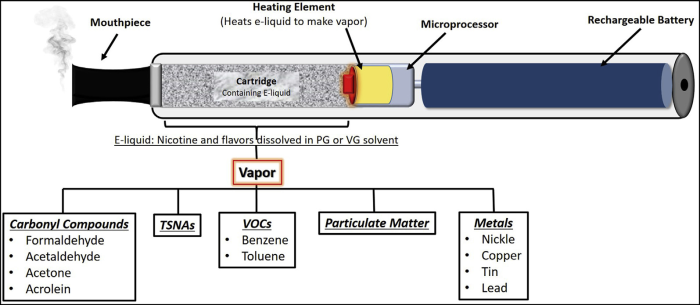E-cigs: What Are They and How Are They Impacting Our Youth?
Since their emergence to the U.S. market in 2007, electronic cigarettes, commonly referred to as E-cigs, are being used both experimentally and regularly in increasing rates by both youths and adults and among chronic smokers and nonsmokers (1-3). Inhaling and exhaling the aerosol of e-cigarettes and other similar devices is known as ‘vaping’. This is in distinction from inhaling the tobacco smoke produced by combustible cigarettes. In November 2018, the Food and Drug Administration (FDA) and the Centers for Disease Control and Prevention (CDC) published results of the 2018 National Youth Tobacco Survey (4, 5) . This survey showed that more than 3.6 million middle and high school students were current (past 30 day) e-cigarette users in 2018, representing a 48% increase among middle school students and a 78% increase among high school students during the period 2017-2018. This dramatic increase in e-cig use, most of which contain nicotine, led to an alarming increase of overall tobacco use in youth: 7.2% of middle school students and 27.1% of American high school students reported using any tobacco product. More than two-thirds of current e-cigarette youth were reported to use flavored e-cigarettes.
What is an E-cig?
The specific design of an e-cig varies with each subsequent generation but continues to consist of three primary components: a power-source (typically a rechargeable lithium battery), the heating element (an atomizer coil), and a reservoir containing the e-liquid (Fig 1). Newer generation models allow for customization of power, resistance, and/or temperature based on user preferences. The e-liquid itself also consists of three primary components: the solvent (either vegetable glycerin and/or propylene glycol), various flavorings and nicotine in various doses. Heat from the atomizer coil after activation of the power source aerosolizes the e-liquid, which is then inhaled, or “vaped,” from the attached mouthpiece. Newer devices can produce less aerosolized vapor, allowing them to be used more discreetly. The highly popular Juul® device resembles an elongated USB drive and utilizes pre-packaged pods containing a proprietary e-liquid with numerous available flavors, including fruit flavor, crème and mint.
While e-liquid solvents and flavors are generally regarded as safe for oral consumption, the effects of their aerosolization and subsequent inhalation are not clearly understood. Moreover, manufacturing labels are not always comprehensive in regards to e-liquid constituents especially with regards to flavorings (6) and therefore may not alert the consumer to the potential for harmful effects. Depending on the combination of solvents and flavors used, a large variation in chemicals can be detected in the resulting aerosol (7, 8) (Figure 1). These chemicals include carbonyl compounds, such as formaldehyde, acetaldehyde, acetone, acrolein; volatile organic compounds, such as benzene and toluene; tobacco-specific nitrosamines; particulate matter; and metals, such as nickel, copper, zinc, tin and lead (7-18). Even when controlling for e-liquid solvent, flavor and nicotine content, variability in the chemical composition of aerosols have been detected within brands (10) as well as within samples of the same product (16) and with the voltage of power used for generation of aerosol (11, 13, 14). Such variability in e-cig aerosol composition highlights some of the previous challenges in evaluating health effects of e-cigs.

J ALLERGY CLIN IMMUNOL
VOLUME 141, NUMBER 6
SOOD, KESIC, AND HERNANDEZ 1975
What are some of the health effects related to e-cig use and asthma?
High school juniors and seniors who reported e-cig use had twice the risk of reporting respiratory symptoms consistent with chronic bronchitis with further increased risk associated with increased e-cig use (19). What is unclear, though, is if these symptoms are secondary to chronic airway inflammation (as noted in asthma and chronic obstructive pulmonary disease, COPD), and/or to increased susceptibility to infection. Other cross-sectional studies of adolescents further suggest that e-cig use is associated with increased prevalence of asthma and chronic bronchitis (20, 21).
Due to the great variability of devices and e-liquid combinations among users, in vitro and animal models have been used to examine the specific biological effects of e-cig constituents. In vitro and mouse models of e-cig exposure have found evidence of cell damage and death, increased inflammation, and impaired defenses against both viruses and bacteria (reviewed by (22)).
Future of e-cigs in the young
In December 2016, the Surgeon General’s report concluded that the use of e-cigs, particularly among youth and young adults, represents an emerging public health concern (23). Given that smoking is widely-known as a leading cause of increased morbidity and mortality due to neoplastic, vascular and respiratory diseases, including chronic obstructive lung disease and asthma (24), the FDA has now extended its tobacco regulatory power to include e-cigs. The overwhelming majority of e-cig users use e-liquids containing nicotine, well known for its addictive properties and neurocognitive effects (24). And although studies to date have had conflicting results regarding the potential of e-cigs to reduce combustible cigarette smoking in adults, the use of any form of tobacco product among youths is thought to be unsafe (25). Prevention and cessation recommendations extend to all forms of nicotine in children and young adults – including combustible cigarettes, e-cigarettes, hookahs and smokeless tobacco. Hookah smoking, for example, carries many of the same health risks as combustible cigarette smoking (26).
The FDA developed a multi-pronged Youth Tobacco Prevention Plan, focused on preventing youth access to tobacco products, curbing marketing of tobacco products aimed at youth and educating teens about the dangers of e-cigs. In response to the increased use of e-cigs reported in the 2018 National Youth Tobacco Survey, the FDA has expanded proposals to limit the sale of flavored products preferred by young users (including varieties such as fruit flavors and vanilla) in person and online. The FDA will be holding a public hearing in January 2019 about strategies to reduce e-cig use among youth, including the use of drug therapies to support cessation efforts.
As healthcare providers, we encourage asking children about the use of e-cigs during medical encounters and educating them about the dangers of e-cigs and nicotine use. The FDA has provided a youth-friendly infographic and other materials to educate tweens and teens that are easily accessible at: https://digitalmedia.hhs.gov/tobacco/print_materials
Podcast Episode 14: The Health Impacts of E-Cigs and Vaping

In this episode, Michelle Hernandez, MD, FAAAAI, discusses the hot topic of e-cigarettes and vaping. Listen now to learn more about these devices, who is using them, how they're being marketed, and the risks associated with use. Testing, especially which types of tests to consider, is covered in detail as well.
Click here to listen to the podcast.
Read the transcript of the conversation.
Find out more about allergies and asthma.
Reviewed: 1/29/19
1. Zhu SH, Zhuang YL, Wong S, Cummins SE, Tedeschi GJ. E-cigarette use and associated changes in population smoking cessation: evidence from US current population surveys. Bmj. 2017;358:j3262.
2. McMillen RC, Gottlieb MA, Shaefer RM, Winickoff JP, Klein JD. Trends in Electronic Cigarette Use Among U.S. Adults: Use is Increasing in Both Smokers and Nonsmokers. Nicotine & tobacco research : official journal of the Society for Research on Nicotine and Tobacco. 2015;17(10):1195-202.
3. Schoenborn CA, Gindi RM. Electronic Cigarette Use Among Adults: United States, 2014. NCHS data brief. 2015(217):1-8.
4. Cullen KA, Ambrose BK, Gentzke AS, Apelberg BJ, Jamal A, King BA. Notes from the Field: Use of Electronic Cigarettes and Any Tobacco Product Among Middle and High School Students - United States, 2011-2018. MMWR Morb Mortal Wkly Rep. 2018;67(45):1276-7.
5. Wang TW, Gentzke A, Sharapova S, Cullen KA, Ambrose BK, Jamal A. Tobacco Product Use Among Middle and High School Students - United States, 2011-2017. MMWR Morb Mortal Wkly Rep. 2018;67(22):629-33.
6. Cheng T. Chemical evaluation of electronic cigarettes. Tobacco control. 2014;23 Suppl 2:ii11-7.
7. Rawlinson C, Martin S, Frosina J, Wright C. Chemical characterisation of aerosols emitted by electronic cigarettes using thermal desorption-gas chromatography-time of flight mass spectrometry. Journal of chromatography A. 2017;1497:144-54.
8. Herrington JS, Myers C. Electronic cigarette solutions and resultant aerosol profiles. Journal of chromatography A. 2015;1418:192-9.
9. Lee MS, LeBouf RF, Son YS, Koutrakis P, Christiani DC. Nicotine, aerosol particles, carbonyls and volatile organic compounds in tobacco- and menthol-flavored e-cigarettes. Environmental health : a global access science source. 2017;16(1):42.
10. Williams M, Bozhilov K, Ghai S, Talbot P. Elements including metals in the atomizer and aerosol of disposable electronic cigarettes and electronic hookahs. PloS one. 2017;12(4):e0175430.
11. Ogunwale MA, Li M, Ramakrishnam Raju MV, Chen Y, Nantz MH, Conklin DJ, et al. Aldehyde Detection in Electronic Cigarette Aerosols. ACS omega. 2017;2(3):1207-14.
12. Flora JW, Wilkinson CT, Wilkinson JW, Lipowicz PJ, Skapars JA, Anderson A, et al. Method for the Determination of Carbonyl Compounds in E-Cigarette Aerosols. Journal of chromatographic science. 2017;55(2):142-8.
13. El-Hellani A, Salman R, El-Hage R, Talih S, Malek N, Baalbaki R, et al. Nicotine and Carbonyl Emissions From Popular Electronic Cigarette Products: Correlation to Liquid Composition and Design Characteristics. Nicotine & tobacco research: official journal of the Society for Research on Nicotine and Tobacco. 2016.
14. Gillman IG, Kistler KA, Stewart EW, Paolantonio AR. Effect of variable power levels on the yield of total aerosol mass and formation of aldehydes in e-cigarette aerosols. Regulatory toxicology and pharmacology : RTP. 2016;75:58-65.
15. Farsalinos KE, Gillman G, Poulas K, Voudris V. Tobacco-Specific Nitrosamines in Electronic Cigarettes: Comparison between Liquid and Aerosol Levels. International journal of environmental research and public health. 2015;12(8):9046-53.
16. Uchiyama S, Senoo Y, Hayashida H, Inaba Y, Nakagome H, Kunugita N. Determination of Chemical Compounds Generated from Second-generation E-cigarettes Using a Sorbent Cartridge Followed by a Two-step Elution Method. Analytical sciences : the international journal of the Japan Society for Analytical Chemistry. 2016;32(5):549-55.
17. Khlystov A, Samburova V. Flavoring Compounds Dominate Toxic Aldehyde Production during E-Cigarette Vaping. Environmental science & technology. 2016;50(23):13080-5.
18. Goniewicz ML, Knysak J, Gawron M, Kosmider L, Sobczak A, Kurek J, et al. Levels of selected carcinogens and toxicants in vapour from electronic cigarettes. Tobacco control. 2014;23(2):133-9.
19. McConnell R, Barrington-Trimis JL, Wang K, Urman R, Hong H, Unger J, et al. Electronic Cigarette Use and Respiratory Symptoms in Adolescents. Am J Respir Crit Care Med. 2017;195(8):1043-9.
20. Cho JH, Paik SY. Association between Electronic Cigarette Use and Asthma among High School Students in South Korea. PLoS One. 2016;11(3):e0151022.
21. Wang MP, Ho SY, Leung LT, Lam TH. Electronic Cigarette Use and Respiratory Symptoms in Chinese Adolescents in Hong Kong. JAMA Pediatr. 2016;170(1):89-91.
22. Sood AK, Kesic MJ, Hernandez ML. Electronic cigarettes: One size does not fit all. J Allergy Clin Immunol. 2018;141(6):1973-82.
23. US Department of Health and Human Services. E-cigarette use among youth and young adults: a report of the Surgeon General. Atlanta, GA: US Department of Health and Human Services, CDC, National Center for Chronic Disease Prevention and Health Promotion, Office on Smoking and Health; 2016. https://e-cigarettes.surgeongeneral.gov/documents/2016_SGR_Full_Report_non-508.pdf [accessed 01/08/2019].
24. Jha P, Ramasundarahettige C, Landsman V, Rostron B, Thun M, Anderson RN, et al. 21st-century hazards of smoking and benefits of cessation in the United States. The New England journal of medicine. 2013;368(4):341-50.
25. Siqueira LM. Nicotine and Tobacco as Substances of Abuse in Children and Adolescents. Pediatrics. 2017;139(1).
26. American Lung Association. An Emerging Deadly Trend: Waterpipe Tobacco Use. [PDF–222 KB] Washington: American Lung Association, 2007 [accessed 01/08/2019].